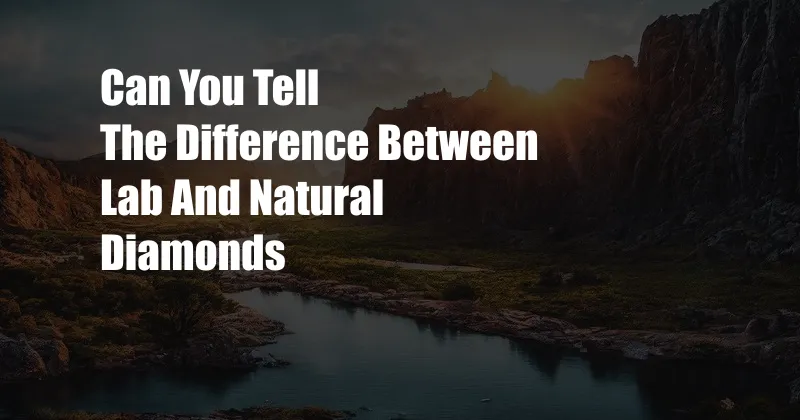
Can You Tell the Difference Between Lab and Natural Diamonds?
Have you ever wondered how you can tell the difference between a lab-created diamond and a natural diamond? When it comes to purchasing a diamond, whether for an engagement ring, an anniversary gift, or any other special occasion, it’s important to know what you’re buying and what factors to consider. In this comprehensive guide, we will delve into the differences between lab-created diamonds and natural diamonds, empowering you with the knowledge to make an informed decision based on your preferences and budget.
Lab-Created Diamonds vs Natural Diamonds: Understanding the Origins
Diamonds are formed through a unique natural process that involves extreme heat and pressure deep within the earth’s mantle. Over billions of years, carbon crystallizes, resulting in the formation of diamonds. These natural diamonds are then mined from the earth’s crust. In contrast, lab-created diamonds are grown in controlled laboratory environments, simulating the natural conditions of diamond formation. Advanced technology allows scientists to create diamonds with similar chemical, physical, and optical properties to natural diamonds, making them virtually indistinguishable to the naked eye.
Properties and Characteristics: Dissecting the Differences
Both lab-created and natural diamonds are composed of pure carbon, exhibiting remarkable hardness and brilliance. However, there are certain subtle differences in their properties and characteristics:
-
Growth Patterns: Natural diamonds often have inclusions or blemishes, which are tiny imperfections or foreign materials trapped within the diamond during its formation. These inclusions can be visible to the naked eye or under magnification. Lab-created diamonds, on the other hand, are grown under controlled conditions, resulting in fewer or no inclusions, making them more visually flawless.
-
Fluorescence: When exposed to ultraviolet light, some diamonds exhibit fluorescence, which causes them to emit a blue glow. Lab-created diamonds tend to have stronger fluorescence than natural diamonds. This difference can be detected using specialized equipment by a trained gemologist.
-
Cut and Polish: The cut and polish of a diamond significantly impact its fire, brilliance, and scintillation. Both lab-created and natural diamonds can be cut and polished to various shapes and sizes, with the quality of the cut and polish affecting the overall appearance and value of the diamond.
Advantages and Considerations: Weighing the Pros and Cons
When it comes to choosing between lab-created and natural diamonds, several factors need to be considered, including cost, environmental impact, and personal preferences:
-
Cost: Lab-created diamonds are typically more affordable than natural diamonds of comparable size and quality, making them a cost-effective option for those looking for a diamond on a budget. The price difference can be significant, with lab-created diamonds costing around 20% to 50% less than natural diamonds.
-
Environmental Impact: Lab-created diamonds have a lower environmental impact compared to natural diamonds. The mining of natural diamonds can disrupt ecosystems, displace local communities, and contribute to greenhouse gas emissions. On the other hand, lab-created diamonds are grown in controlled environments with minimal environmental impact, making them a more sustainable choice.
-
Personal Preferences: Ultimately, the choice between a lab-created diamond and a natural diamond is a matter of personal preference and budget. Natural diamonds carry the allure of being formed over billions of years through natural processes, while lab-created diamonds offer a more affordable and environmentally friendly option.
Expert Insights and Tips: Enhancing Your Knowledge
To further enhance your understanding of the differences between lab-created and natural diamonds, here are some expert insights and tips:
-
Consult with a Gemologist: If you are unsure about the origin of your diamond, it is advisable to consult with a certified gemologist. Gemologists possess the necessary expertise and equipment to accurately determine whether a diamond is lab-created or natural.
-
Consider Fluorescence: Fluorescence can be a distinguishing factor between lab-created and natural diamonds. If you are concerned about the fluorescence of your diamond, ask your jeweler to test it under ultraviolet light.
-
Read the Certificate: When purchasing a diamond, regardless of whether it is lab-created or natural, it is essential to obtain a certificate from a reputable gemological laboratory. The certificate will provide詳細な情報 on the diamond’s characteristics, including its origin, grading, and any treatment or enhancements.
Frequently Asked Questions: Answering Your Queries
-
How can I be sure that my lab-created diamond is genuine?
Ensure that your lab-created diamond comes with a certificate from a reputable gemological laboratory, such as the Gemological Institute of America (GIA) or the International Gemological Institute (IGI). This certificate should clearly state that the diamond is lab-created. -
Which is better, a lab-created or natural diamond?
Both lab-created and natural diamonds share similar properties, making the choice a matter of personal preference and budget. Natural diamonds carry the allure of being formed naturally over billions of years, while lab-created diamonds are more affordable and have a lower environmental impact. -
Can I tell the difference between a lab-created and natural diamond without a microscope?
To the untrained eye, it may be challenging to distinguish between a lab-created and natural diamond without a microscope or specialized equipment. However, a skilled jeweler can examine the diamond’s fluorescence and symmetry to make an informed assessment.
Conclusion
Ultimately, the decision of whether to choose a lab-created or natural diamond is a personal one. Both options have their own unique advantages and considerations. By understanding the differences and seeking guidance from experts, you can make an informed choice that suits your preferences and budget. Whether you opt for the timeless allure of a natural diamond or the cost-effective and sustainable option of a lab-created diamond, let the sparkle of your choice bring joy and meaning to your life.
Share your thoughts and questions in the comments section below. Are you interested in learning more about the fascinating world of diamonds?